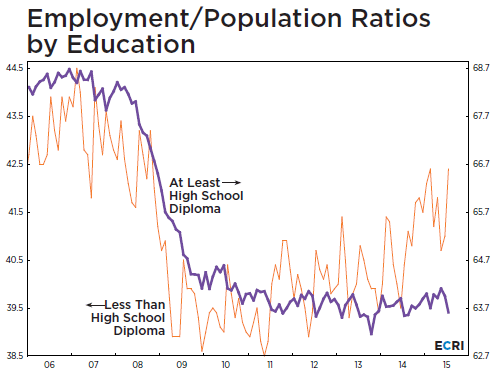By ECRI
The sustained decline in the official jobless rate – now approaching the Fed’s estimate of “full employment” – is a misleading indicator of labor market slack. Indeed, the stagnation in nominal wage growth is consistent with the weakness in the employment/population (E/P) ratio. That said, even the E/P ratio may be overstating the health of the jobs market.
After dropping to three-decade lows in the wake of the Great Recession, the E/P ratio, has barely improved since the fall of 2013, reversing only about one-fifth of its decline from its pre-recession highs. Furthermore – as a breakdown of the E/P ratio by education level shows –this modest improvement is illusory.

Since 2011, when the E/P ratio for those with less than a high school diploma bottomed, that metric has regained almost two-thirds of its recessionary losses (orange line in chart). But the E/P ratio for high school or college graduates – i.e., eight out of nine American adults – has not recovered any of its recessionary losses, and stands about where it started, one, two and three years ago (purple line).
This data shows that the so-called jobs recovery has been spearheaded by cheap labor, with job gains going disproportionately to the least educated — and lowest-paid — workers. This is scarcely a good basis for resilient consumer spending driven by “solid” job growth that the consensus – including the Fed – is banking on.


